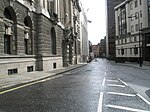Old Bailey

The Central Criminal Court of England and Wales, commonly referred to as the Old Bailey after the street on which it stands, is a criminal court building in central London, one of several that houses the Crown Court of England and Wales. The street outside follows the route of the ancient wall around the City of London, which was part of the fortification's bailey, hence the metonymic name. The Old Bailey has been housed in a succession of court buildings on the street since the sixteenth century, when it was attached to the medieval Newgate gaol. The current main building block was completed in 1902, designed by Edward William Mountford; its architecture is recognised and protected as a Grade II* listed building. An extension South Block was constructed in 1972, over the former site of Newgate gaol which was demolished in 1904. The Crown Court sitting in the Old Bailey hears major criminal cases from within Greater London. In exceptional cases, trials may be referred to the Old Bailey from other parts of England and Wales. As with most courts in England and Wales, trials at the Old Bailey are open to the public; however, they are subject to stringent security procedures.
Excerpt from the Wikipedia article Old Bailey (License: CC BY-SA 3.0, Authors, Images).Old Bailey
Schlosspark, Kassel Bad Wilhelmshöhe
Geographical coordinates (GPS) Address Nearby Places Show on map
Geographical coordinates (GPS)
| Latitude | Longitude |
|---|---|
| N 51.515833333333 ° | E -0.10194444444444 ° |
Address
Löwenburg
Schlosspark 9
34131 Kassel, Bad Wilhelmshöhe
Hessen, Deutschland
Open on Google Maps










